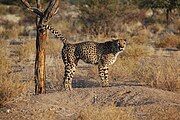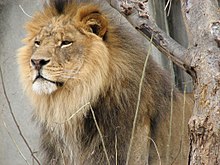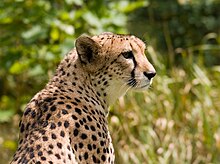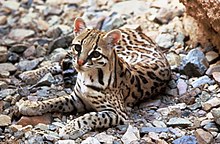From Wikipedia, the free encyclopedia
| Felids[1] Temporal range: 25–0Ma Late Oligocene to Recent |
|
|---|---|
 |
|
| Tiger (Panthera tigris) | |
| Scientific classification | |
| Kingdom: | Animalia |
| Phylum: | Chordata |
| Class: | Mammalia |
| Order: | Carnivora |
| Suborder: | Feliformia |
| Family: | Felidae G. Fischer de Waldheim, 1817 |
| Subfamilies | |
|
Felinae Pantherinae †Machairodontinae †Proailurinae[2] |
|
 |
|
| Felidae ranges | |
Extant felids belong to one of two subfamilies: Pantherinae (which includes the tiger, the lion, the jaguar, and the leopard), and Felinae (which includes the cougar, the cheetah, the lynxes, the ocelot, and the domestic cat).
The first felids emerged during the Oligocene, about 25 million years ago. In prehistoric times, a third subfamily, known as Machairodontinae, included the "saber-toothed cats", such as the well known Smilodon. Other superficially cat-like mammals, such as the marsupial sabertooth Thylacosmilus or the Nimravidae, are not included in Felidae despite superficial similarities.
Felids are the strictest carnivores of the 13 terrestrial families in the order Carnivora, although the three families of marine mammals comprising the superfamily Pinnipedia are as carnivorous as the felids.
Contents
Evolution
There are 41 known species of felids in the world today, all of which are descended from the same ancestor.[1] This taxon originated in Asia and spread across continents by crossing land bridges. Testing of mitochondrial and nuclear DNA by Warren Johnson and Stephen O'Brien of the US National Cancer Institute demonstrated the ancient cats evolved into eight main lineages that diverged in the course of at least 10 migrations (in both directions) from continent to continent via the Bering land bridge and Isthmus of Panama, with the Panthera genus being the oldest and the Felis genus being the youngest. They estimated 60% of the modern species of cats developed within the last million years.[3]Most felids have a haploid number of 18 or 19. New World cats (those in Central and South America) have a haploid number of 18, possibly due to the combination of two smaller chromosomes into a larger one.[4] Prior to this discovery, biologists had been largely unable to establish a family tree of cats from the fossil record because the fossils of different cat species all look very much alike, differing primarily in size.
The felids' closest relatives are thought to be the Asiatic linsangs,[5] and at one remove the group of civets, hyenas, mongooses, and Madagascar carnivores,[6] with whom they share the Suborder Feliformia. Most felid species share a genetic anomaly that prevents them from tasting sweetness.[7]
Characteristics
Felids are obligate carnivores, requiring a diet of meat and organs to survive. Aside from the lion, wild felids are generally solitary; feral domestic cats do, however, form feral cat colonies. Cheetahs are also known to live and hunt in groups. Felids are generally secretive animals, are often nocturnal, and live in relatively inaccessible habitats. Around three-quarters of cat species live in forested terrain, and they are generally agile climbers. However, felids may be found in almost any environment, with some species being native to mountainous terrain or deserts.Wild felids are native to every continent except Australasia and Antarctica.
Physical appearance

Skull of the machairodontine Smilodon (reconstruction)
The various species of felids vary greatly in size. One of the smallest is the black-footed cat, measuring 35 to 40 cm (14 to 16 in) long, while the largest in the wild is the tiger, which can attain up to 350 cm (11.5 ft) in length[9] and weigh 300 kilograms (660 lb).
The fur of felids takes many different forms, being much thicker in those species living in cold environments, such as the snow leopard. The color of felids is also highly variable—although brown to golden fur is common in most species—usually marked with distinctive spots, stripes, or rosettes. The only felids to lack significant markings are the lion, puma, caracal and jaguarundi. Many species exhibit melanism, in which some individuals have an all-black coat.[8]
The tongue of felids is covered with horny papillae, which rasp meat from prey and aid in grooming.
All felids have protractible claws, in other words they have the ability to protract their claws from a retracted, at-rest position. Although in a few species, such as the cheetah, the claws remain visible even when at rest (retracted). The claws are retracted when the animal is relaxed and protracted when they are in use. They are attached to the terminal bone of the toe with a tough ligament; when the animal contracts muscles in the toe to straighten it, the ligament forces the claw outwards.[8] Cats have five toes on their forefeet and four on their hindfeet, reflecting their reliance on gripping and holding down their prey with their claws.[citation needed] In Felidae, the baculum is shorter than in Canidae.[10]
Senses
Felids have relatively large eyes, situated to provide binocular vision. Their night vision is especially good due to the presence of a tapetum lucidum, which reflects light back inside the eyeball, and gives felid eyes their distinctive shine. As a result, the eyes of felids are about six times more light sensitive than those of humans, and many species are at least partially nocturnal. The retina of felids also contains a relatively high proportion of rod cells, adapted for distinguishing moving objects in conditions of dim light, which are complemented by the presence of cone cells for sensing color during the day. However, felids appear to have relatively poor color vision in comparison with humans.[8] This is explained by the fact that felids see moving objects more "colorfully" than still objects, but in an intact environment, are unable to distinguish color tones alone (like turquoise compared to teal, for example).[citation needed]The external ears of felids are also large, and especially sensitive to high-frequency sounds in the smaller cats. This sensitivity allows them to locate small rodent prey; cats themselves do not apparently produce such sounds.[8]
Felids also have a highly developed sense of smell, although not to the degree seen in canids; this is further supplemented by the presence of a vomeronasal organ in the roof of the mouth, allowing the animal to "taste" the air. The use of this organ is associated with the Flehmen response, in which the upper lip is curled upwards. Most felids are unable to taste sweetness due to a mutated gene in their taste buds. Exceptions include members of the genera Leopardus and Otocolobus.[citation needed]
Felids possess highly sensitive whiskers set deep within the skin, which provide the cat with sensory information about the slightest air movement around it. For this reason, whiskers are very helpful to nocturnal hunters.
Most felids are able to land on their feet after a fall, an ability that relies on vision and the sense of balance acting together.[citation needed]
Dentition
Felids have a relatively small number of teeth compared with other carnivorans, a feature associated with their short muzzles. With a few exceptions, such as the lynx, they have the dental formula: 3.1.3.13.1.2.1. The canine teeth are large, reaching exceptional size in the extinct saber-tooth species. The upper third premolar and lower molar are adapted as carnassial teeth, suited to tearing and cutting flesh.[8]The jaws of felids can only move vertically. This prevents them from being able to chew efficiently, but makes it easier for their powerful masseter jaw muscles to hold struggling prey.
Vocalisations
All felids share a broadly similar set of vocalisations, but with some variation between species. In particular, the pitch of calls varies, with larger species producing deeper sounds; overall, the frequency of felid calls ranges between 50 and 10,000 hertz.All felids are able to spit, hiss, growl, snarl, and mew. The first four sounds are all used in an aggressive context. The spitting sound is a sudden burst, typically used when making threats, especially towards other species. The hiss is a prolonged, atonal sound used in close range to other members of the species, when the animal is uncertain whether to attack or retreat. Growling is used to indicate a willingness to attack, while the higher-pitched snarl is used when adopting a defensive posture.
The mewing sound may be used either as a close-contact call, typically between a mother and kittens, or as a louder, longer distance call, primarily during the mating season. The acoustic properties of the mew vary somewhat between different felid species; extreme examples include the whistling sound made by cougars and the mew-grunt of lions and tigers.
Most felids seem to be able to purr, vibrating the muscles in their larynx to produce a distinctive buzzing sound. In the wild, purring is used while a mother is caring for kittens. Precisely which species of felid are able to purr is a matter of debate, but the sound has been recorded in most of the smaller species, as well as the cheetah and cougar, and may also be found in the big cats.
Other common felid vocalisations include the gurgle, wah-wah, prusten, and roar. The first two sounds are found only among the Felinae (small cats). Gurgling is a quiet sound used during meetings between friendly individuals, as well as during courtship and when nursing kittens. The wah-wah is a short, deep-sounding call used in close contact, and is not found in all species (it is, for example, absent in the domestic cat).
In contrast, prusten and roaring are found only in big cats. Prusten is a short, soft, snorting sound reported in tigers, jaguars, snow leopards, and clouded leopards; it is used during contact between friendly individuals. The roar is an especially loud call with a distinctive pattern that depends on the species. The ability to roar comes from an elongated and specially adapted larynx and hyoid apparatus.[11] When air passes through the larynx on the way from the lungs, the cartilage walls of the larynx vibrate, producing sound. Only lions, leopards, tigers and jaguars are truly able to roar, although the loudest mews of snow leopards have a similar, if less structured, sound.[8] Tigers and jaguars have a very snarly roar, while the roar of leopards and lions is much more throaty.[citation needed]
Social and territorial behavior
Territorial marking
Within the Felidae, male felids usually urinate backwards by curving the tip of the glans penis backward.[12][10] Urine marking by felids is also known as "spray-urinating"[13] or "spray-marking".[14] To identify their territories, male tigers mark trees by spraying urine[15][16] and anal gland secretions, as well as marking trails with scat. Males show a grimacing face, called the Flehmen response, when identifying a female's reproductive condition by sniffing their urine markings.Lions use urine to mark their territories. They often scrape the ground while urinating, and the urine often flows in short spurts, instead of flowing continuously. They often urinate on vegetation, or on tree trunks at least one meter high.[17]
Male cheetahs mark their territory by urinating on objects that stand out, such as trees, logs, or termite mounds. The whole coalition contributes to the scent. Males will attempt to kill any intruders, and fights result in serious injury or death.[18] When male cheetahs urine-mark their territories, they stand a meter away from a tree or rock surface with the tail raised, pointing the penis either horizontally backward or 60° upward.[19] The odor of cheetah urine (unlike that of other large felids) cannot be easily detected by humans.[20]
Black-footed cats use scent marking throughout their ranges, with males spraying urine up to 12 times an hour.[8]
Classification
Traditionally, five subfamilies have been distinguished within the Felidae based on phenotypical features: the Felinae, the Pantherinae, the Acinonychinae (cheetahs), the extinct Machairodontinae, and the extinct Proailurinae.[2]Genetic classification
Genetic research has provided a basis for a more concise classification for the living members of the cat family based on genotypical groupings.[1][21][22] Specifically, eight genetic lineages have been identified:[23]- Lineage 1 Pantherinae : Panthera, Uncia, Neofelis
- Lineage 2: Pardofelis, Catopuma
- Lineage 3: Leptailurus, Caracal, Profelis
- Lineage 4: Leopardus
- Lineage 5: Lynx
- Lineage 6: Puma, Acinonyx
- Lineage 7: Prionailurus, Otocolobus
- Lineage 8: Felis
Extant species
The following is the complete list of genera within family Felidae, grouped according to the traditional phenotypical classification with the corresponding genotypical lineages indicated:[1]- Subfamily Pantherinae
- Genus Panthera [Lineage 1]
- Genus Uncia [Lineage 1]
- Snow leopard (Uncia uncia)
- Genus Neofelis [Lineage 1]
- Clouded leopard (Neofelis nebulosa)
- Sunda clouded leopard (Neofelis diardi)
- Subfamily Felinae
- Genus Pardofelis [Lineage 2] — since 2006, this genus is defined as also comprising Bay cat and Asian golden cat;[21]
- Marbled cat (Pardofelis marmorata)
- Genus Catopuma [Lineage 2]
- Bay cat (Catopuma badia) — syn. Pardofelis badia;[21]
- Asian golden cat (Catopuma temminckii) — syn. Pardofelis temminckii;[21]
- Genus Leptailurus [Lineage 3]
- Serval (Leptailurus serval)
- Genus Caracal [Lineage 3]
- Caracal (Caracal caracal)
- Genus Profelis [Lineage 3]
- African golden cat (Profelis aurata)
- Genus Leopardus [Lineage 4]
- Pantanal cat (Leopardus braccatus)
- Colocolo (Leopardus colocolo)
- Geoffroy's cat (Leopardus geoffroyi)
- Kodkod (Leopardus guigna)
- Andean mountain cat (Leopardus jacobitus)
- Pampas cat (Leopardus pajeros)
- Ocelot (Leopardus pardalis)
- Oncilla (Leopardus tigrinus)
- Margay (Leopardus wiedii)
- Genus Lynx [Lineage 5]
- Canadian lynx (Lynx canadensis)
- Eurasian lynx (Lynx lynx)
- Iberian lynx (Lynx pardinus)
- Bobcat (Lynx rufus)
- Genus Puma [Lineage 6]
- Cougar (Puma concolor)
- Jaguarundi (Puma yagouaroundi)
- Genus Acinonyx[24][Lineage 6]
- Cheetah (Acinonyx jubatus)
- Genus Prionailurus [Lineage 7]
- Leopard cat (Prionailurus bengalensis)
- Iriomote cat (Prionailurus bengalensis iriomotensis)
- Flat-headed cat (Prionailurus planiceps)
- Rusty-spotted cat (Prionailurus rubiginosus)
- Fishing cat (Prionailurus viverrinus)
- Leopard cat (Prionailurus bengalensis)
- Genus Otocolobus [Lineage 7]
- Pallas's cat (Otocolobus manul)
- Genus Felis [Lineage 8]
- Chinese mountain cat (Felis bieti)
- Domestic cat (Felis catus)
- Jungle cat (Felis chaus)
- Sand cat (Felis margarita)
- Black-footed cat (Felis nigripes)
- Wildcat (Felis silvestris)
- Genus Pardofelis [Lineage 2] — since 2006, this genus is defined as also comprising Bay cat and Asian golden cat;[21]
Fossil felids

The American lion was one of the abundant Pleistocene megafauna, a wide variety of very large mammals that went extinct about 10,000 years ago.[25]
Genera of the Felidae
The list follows McKenna and Bell's Classification of Mammals for prehistoric genera (1997)[2] and Wozencraft (2005) in Wilson and Reeder's Mammal Species of the World for extant genera.[1] Pseudaelurus is included in the Felinae as per McKenna & Bell, despite its basal position in felid evolution. Inconsistent with McKenna and Bell, three additional prehistoric genera, Miracinonyx, Lokontailurus and Xenosmilus, are listed. Sivapanthera is included in the Felinae (not Acinonychinae) and Ischrosmilus is included in the genus Smilodon.- †Proailurinae
- Felinae
- Pantherinae
- †Machairodontinae
- †Machairodus (Late Miocene, Africa, Eurasia, North America)
- †Homotherium (Pliocene, Pleistocene; Africa, Eurasia, North America)
- †Xenosmilus (Pleistocene; North America)
- †Lokotunjailurus (Latest Miocene; Africa)
- †Miomachairodus (Middle Miocene; Africa, Asia)
- †Hemimachairodus
- †Paramachairodus (Late Miocene; Eurasia, Africa)
- †Megantereon (Pliocene, Pleistocene; North America, Africa, Eurasia)
- †Smilodon (Late Pliocene to Late Pleistocene; North- and South America)














No comments:
Post a Comment